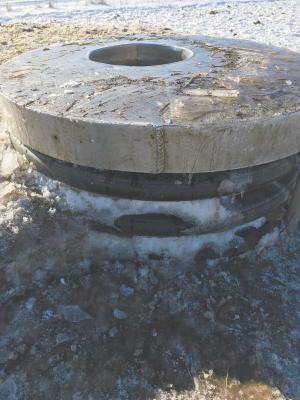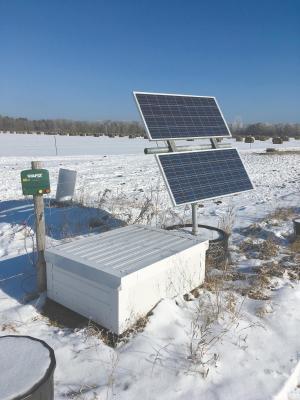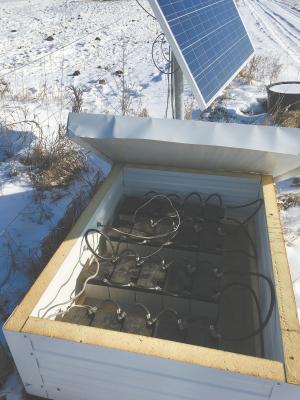Solar-Powered Geothermal Watering System
Bill Kolodziej keeps water flowing to his 100-head cattle herd no matter what the temperature, thanks to his solar-powered geothermal watering system. The 1,780-watt solar panels and a bank of 20 long-cycle, 12-volt batteries power the 24-volt DC submersible pump. Winter water access is assured with an insulated, earth- warmed water tank and an ultra-low voltage connection instead of a float.
“The system is kind of a copy of one developed by the Alberta Ministry of Agriculture and Forestry,” says Kolodziej. “The control system has 2 stainless steel needles. They maintain an ultra-low voltage connection when in water. When the water level falls or freezes over, the connection fails, and the pump turns on.”
In the case of ice, the pump runs until warm water thaws out the connection. The actual watering hole consists of an 8-ft., 30-in. culvert placed vertically in the ground. A foam insulated, 24-in. dia., culvert insert sits in the upper 4 ft. of the larger culvert. An aluminum cap with a 10-in. dia. hole caps the 2 culverts. The combination of insulated upper culvert and earth-warmed lower culvert keeps the water from freezing solid.
“When temperatures recently hit 29 degrees below zero, there was a thin layer of ice on it,” says Kolodziej. “I cleared it away, and once the cattle started drinking and the pump started up, the water stayed ice free. Unlike standard electric waterers that can freeze solid, this one always has ground-heated water underneath.”
Kolodziej set the 8-ft. culvert in the ground to a depth of 5 ft. A raised area of dirt topped by a 12 by 12-ft. concrete pad surrounds the waterer. This reduces mud problems and protects the water hole.
An insulated chest protects the batteries from the weather, including cold winter temperatures. The entire system cost about $4,000, not including well drilling.
“I work off the farm and wanted a watering system that would take minimal time and care, especially in the winter,” says Kolodziej. “The panels and battery provide enough power to pump about 3 gal. per min., as well as power a 12-volt fence energizer.”
The fencer is another element of low maintenance cattle feeding. Kolodziej uses polywire fencing on fiberglass posts to fence off enough bales for a week’s feed for the herd. He places bale rings around the apportioned bales. The fiberglass posts with their hot wires are pushed into remaining bales to keep the cattle away.
The winter paddock is a sandy field that was row cropped for many years. The cattle manure fertilizes the soil, while seed heads found in the low-quality hay Kolodziej feeds reseeds the field.
“With larger bales, I can go 10 days without moving the wires or bale rings,” says Kolodziej.
Contact: FARM SHOW Followup, William D. Kolodziej, Marathon County Conservation, Planning and Zoning Dept., 210 River Dr., Wausau, Wis. 54403 (ph 715 261-6038 or 715 581-1125; william.kolodziej@co.marathon.wi.us).

Click here to download page story appeared in.
Click here to read entire issue
Solar-Powered Geothermal Watering System ENERGY Solar Bill Kolodziej keeps water flowing to his 100-head cattle herd no matter what the temperature thanks to his solar-powered geothermal watering system The 1 780-watt solar panels and a bank of 20 long-cycle 12-volt batteries power the 24-volt DC submersible pump Winter water access is assured with an insulated earth- warmed water tank and an ultra-low voltage connection instead of a float “The system is kind of a copy of one developed by the Alberta Ministry of Agriculture and Forestry ” says Kolodziej “The control system has 2 stainless steel needles They maintain an ultra-low voltage connection when in water When the water level falls or freezes over the connection fails and the pump turns on ” In the case of ice the pump runs until warm water thaws out the connection The actual watering hole consists of an 8-ft 30-in culvert placed vertically in the ground A foam insulated 24-in dia culvert insert sits in the upper 4 ft of the larger culvert An aluminum cap with a 10-in dia hole caps the 2 culverts The combination of insulated upper culvert and earth-warmed lower culvert keeps the water from freezing solid “When temperatures recently hit 29 degrees below zero there was a thin layer of ice on it ” says Kolodziej “I cleared it away and once the cattle started drinking and the pump started up the water stayed ice free Unlike standard electric waterers that can freeze solid this one always has ground-heated water underneath ” Kolodziej set the 8-ft culvert in the ground to a depth of 5 ft A raised area of dirt topped by a 12 by 12-ft concrete pad surrounds the waterer This reduces mud problems and protects the water hole An insulated chest protects the batteries from the weather including cold winter temperatures The entire system cost about $4 000 not including well drilling “I work off the farm and wanted a watering system that would take minimal time and care especially in the winter ” says Kolodziej “The panels and battery provide enough power to pump about 3 gal per min as well as power a 12-volt fence energizer ” The fencer is another element of low maintenance cattle feeding Kolodziej uses polywire fencing on fiberglass posts to fence off enough bales for a week’s feed for the herd He places bale rings around the apportioned bales The fiberglass posts with their hot wires are pushed into remaining bales to keep the cattle away The winter paddock is a sandy field that was row cropped for many years The cattle manure fertilizes the soil while seed heads found in the low-quality hay Kolodziej feeds reseeds the field “With larger bales I can go 10 days without moving the wires or bale rings ” says Kolodziej Contact: FARM SHOW Followup William D Kolodziej Marathon County Conservation Planning and Zoning Dept 210 River Dr Wausau Wis 54403 ph 715 261-6038 or 715 581-1125; william kolodziej@co marathon wi us
To read the rest of this story, download this issue below or click
here to register with your account number.









